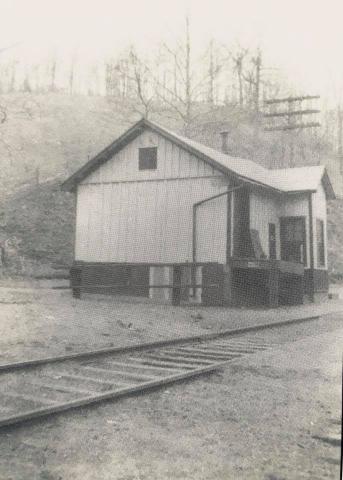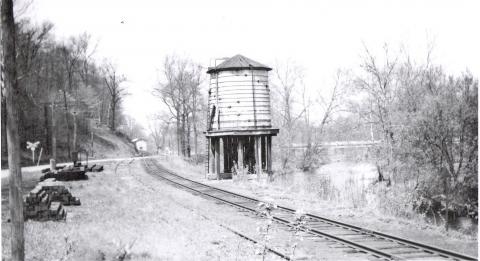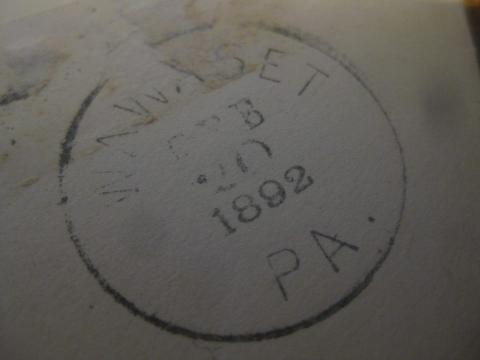Wawaset
The rural area known today as Wawaset had early beginnings as a fording location across the western branch of the Brandywine Creek.
Prior to 1834 the rural area was known as Seeds' Ford, so named for the farm family that owned significant acreage on either side of the Brandywine at that location. Emmor Seeds owned the farm property on the north side of the Brandywine and his brother George owned property to the southeast across the creek.
By 1834 a new roadway project was underway running through the area. The section of the State Road (current Route 842) was built to connect rural communities between West Chester, Pennsylvania and the state line near present day Fair Hill, Maryland. A new wooden covered bridge was constructed to replace the earlier ford at that location. Seeds' Bridge was a 3 span Burr arch type structure with a length of 270 feet and a roadway width of 15 feet. It was the longest covered bridge to be built in Chester County.

In 1870 the Wilmington and Reading Railroad opened connecting Wilmington, Delaware to the coal regions near Reading, Pennsylvania. A station would be constructed near the end of Seeds Bridge and would initially be called Seeds Bridge Station. The roadway approach to the southern end of the bridge had to be modified to allow for the right of way for the new railroad. Adjacent to the new station an elevated wooden water tank would be built to fill steam locomotives stopped at the station. The water would be pumped from the Brandywine Creek likely via a ram jet pump using the velocity of the current to propel the water up a pipe into the tank. The rail stop initially included a coal dump which allowed local residents to access coal to heat their homes, a relatively new advancement for the time made more affordable by the railroad.

By the early 1880's additional businesses would be located near the rail stop. A coal yard was located adjacent to the railroad near a frame bran warehouse. A short spur line connected the early depot businesses to the main track. In 1884 landowner Lewis Wilkinson constructed a new Rural Gothic style dwelling house on the lot adjacent to his bran warehouse. The spur line was removed and the railroad right of way passed in front of the new residence. The house was of a simple cross gable design and had a simple front porch adorned with turned posts and ornamental brackets. The body of the house feature characteristic wooden quoins on the corners, wooden German siding, and hinged wooden shutters mounted on 2 over 2 divided light sash windows.The casings were simple flat boards with a simple head detail, similar in style to the adjacent bran warehouse. The house was put on the National Register of HHistoric Places in 1985 as part of the Northbrook Historic District.
Wilkinson's businesses thrived in the late 19th century. Regular coal deliveries were made to the bins located between the railroad and the roadway.
 In 1885 residents petitioned for a US Post Office to be located at the rail stop. On August 17, 1885 the new Post Office, named Wawaset was opened with W.J. Pratt as the first Postmaster. The name Wawaset was chosen by the railroad management as it was the name the Lenni-Lenape Indians gave to the Brandywine: wawassan, a word roughly translated “the settling place of the wild geese. The rail station also took on the name of the new Post Office and the area became known as Wawaset from that point on.
In 1885 residents petitioned for a US Post Office to be located at the rail stop. On August 17, 1885 the new Post Office, named Wawaset was opened with W.J. Pratt as the first Postmaster. The name Wawaset was chosen by the railroad management as it was the name the Lenni-Lenape Indians gave to the Brandywine: wawassan, a word roughly translated “the settling place of the wild geese. The rail station also took on the name of the new Post Office and the area became known as Wawaset from that point on.
Located just west of the Wilkinson House was a 3 structure property owned by Jesse Webb. There were 2 stone dwelling houses and a frame blacksmith shop close to where the railroad tracks crossed State Road.
In the 1890's there was a contract awarded to a company near the Wawaset Station to deliver crushed granite to be used for the rail bed of the trolley line being constructed between West Chester and Lenape. It is thought that the site of the quarry was likely located nearby the Wilkinson House or on the hillside above the station. If you drive up South Wawaset Road today you can see multiple granite outcroppings in the woodlands along the roadway.
Passenger rail service ended at Wawaset before 1947 when the rest of the extended rail line was reserved just for freight. By that time the quarry, coal, and bran businesses had long been ceased at Wawaset mainly due to advancements in roadways and improved transportation technology.
Wawaset Station, the spur line over the coal bins, bran warehouse, water tower, and blacksmith shop have all disappeared since the mid 20th century. In the early 1990's the Wilkinson House was partially destroyed by a fire that burned the roof and part of the second floor. The home was reconstructed in the character of the original but the Rural Gothic details such as the cross gable, wooden quoins, porch post brackets, and wooden shutters were not reconstructed. The early 19th century Jesse Webb dwelling house still stands along the railway and has been enlarged over the years. The abutments for the coal bins can still be seen along Route 842 along the railroad bed. The stone and concrete foundation for the water tower can still be seen between South Wawaset Road and the Brandywine. Seeds' Bridge was demolished in 1932 and replaced by an open span concrete bridge using the original stone abutments. That bridge served until the 1990's when it was completely replaced by a modern concrete and steel bridge built on new concrete foundations.

